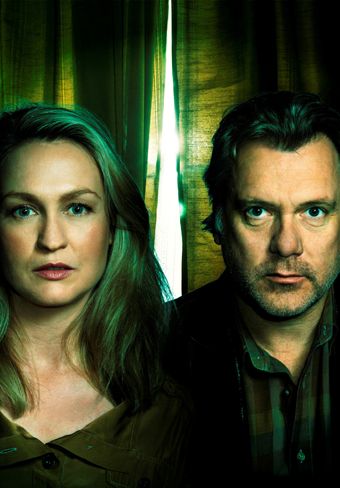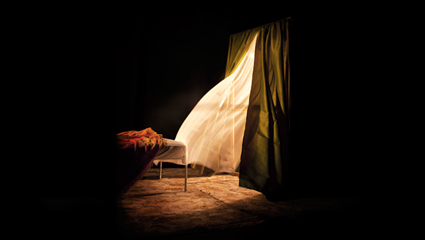demonic doubt & puppet art
keith gallasch: interview, hilary bell, the splinter, stc

Helen Thomson, Erik Thomson, The Splinter, Sydney Theatre Company
photo James Green
Helen Thomson, Erik Thomson, The Splinter, Sydney Theatre Company
PETER BARCLAY DESCRIBED HILARY BELL’S THE BLOODY BRIDE, THE PRODUCT OF NORPA’S GENERATOR PROGRAM IN LISMORE, NSW, AS “A DARK JOURNEY INTO THE INTIMATE EMOTIONS AND CONFLICTING ETHICS OF RELATIONSHIPS AND SEXUALITY…A MOST PROVOCATIVE PIECE OF THEATRE (RT87).” THE WRITER’S WIDELY PRODUCED PLAYS, WHETHER FOR ADULTS OR YOUNG AUDIENCES, HAVE ATTRACTED CONSISTENT PRAISE, NOT LEAST FOR WOLF LULLABY (1996), AN AUSTRALIAN CLASSIC.
Bell has been busy with two works already produced in 2012: The White Divers of Broome for Black Swan State Theatre Company in Perth and Victim Sidekick Boyfriend Me for the National Theatre’s Connections Program in London. Now Sydney Theatre Company is producing The Splinter, a haunting tale of an abducted child returned to her parents—but is she in fact theirs? I met Bell to discuss what attracted her to this doubly disturbing scenario.
What did you set out to write?
I have a real penchant for gothic horror and psychological drama. I read Robert Louis Stevenson (Dr Jekyll and Mr Hyde), Henry James’ The Turn of the Screw, (Bram Stoker’s) Dracula—some fantastic stuff—and came up with a treatment, which was all the company wanted initially for a play from me for children. They looked at the treatment for The Splinter and said, “We can’t put this on for children; they’ll be terrified!” (LAUGHS) It was a bit too scary but also it’s a play which depends on its power of suggestion. And I think you need to be a grown-up—or maybe a teenager—to understand how that splinter of doubt can grow and infect your whole view of the world. It’s a grown-up’s play.
Is it inspired by any substitute child stories in particular or did that just come to you?
I guess I’ve had a bit of an ongoing fascination with fairy law and changelings in particular. Fairytales in general are just so rich and so deceptively simple. There’s so much going on underneath.
It seems from reading the play that you aim for a kind of apparent simplicity. There’s not a lot of back-story, just hints from time to time. It’s all very much in the present, very fable-like. There’s even a fairy story in it.
Yes, that’s one of the things that Polly Rowe as dramaturg has been doing—encouraging me to lift out too many contemporary references. I want a couple. Choc-drops I wanted to keep.
You can get too ethereal. You have to be careful, don’t you, that that the play doesn’t become ‘unearthed.’
Yes, you’ve got to have some anchors there.
But on the other hand it feels very concrete because of the intense relationship between the couple. It’s very frank actually.
I think it’s been a really healthy marriage and they have survived that trauma of losing their child, which not a lot of couples do. I guess that was one of the inspirations for me for this play: that question of when you get everything you want, when you’ve been through absolute hell and your child is restored to you, that should be the happy ending. I read about a teenager who had been stolen from her bed and returned nine months later. It happened in the US and I was living there at the time. There were hurrahs and celebration all over the newspapers. I couldn’t help thinking, how do you as a family achieve some kind of normalcy after your child has been through that—the things she’s seen, the things she’s had to confront, the places that you as parents have been—the dark recesses that you’ve had to explore?
The fear that the child has been violated?
Well, that girl had been, horribly and repeatedly.
But in The Splinter we don’t know, which probably makes it worse in a way.
In some ways it does. And what would it be like to sit down to dinner again as a family? What would you talk about? I don’t think it would be “How was your day?” Would you talk about anything? So that was actually the first scene I wrote and I called it ‘Eggshells’ because I thought it would be like walking on eggshells—the things you couldn’t say, the dangerous territory. What bits of land are left for you to walk on when everything is so fraught but you’re also brimming over with gratitude?
Many relationships come unstuck once someone is lost. It’s like the glue that was there is gone and there’s a desire to blame. Guilt is an interesting component in your play.
A lot of it is guilt to do with the husband’s suspicious mind. Ultimately there’s a point in the final scene when his wife says, “Whatever you’ve been thinking, wherever you’ve been in your imagination, I accept you and I forgive you and I accept responsibility for pushing you there and let’s just get on with it now.” And he is forced to admit, “Well, if Laura is not that person, if she’s not everything I’ve impugned her with, then what does that make me?” He can’t bear the notion of what that makes him. It’s actually safer and more comfortable to continue on an insane trajectory. There have been many inspirations for this play but that came from The Turn of the Screw. I read it twice. The first time I thought the children were possessed and the governess was a heroine. The second time I thought she’s bonkers and she’s projecting all this stuff onto these two innocent children. And there’s a moment towards the climax where she has that exact thought: if these children are innocent, then who am I, what does that make me?

The Splinter
courtesy STC
The Splinter
The play’s a very interesting study of a male going to pieces and you take it pretty far. It’s almost hallucinatory—and poetically so.
There were times right at the very beginning of the process where I was thinking, well does it matter which is the father and which is the mother. I thought it’d be interesting to study what it’s like for a father in this situation. And one thing that I guess I instinctively knew about—and we’ve been unpacking it in rehearsals—is that bond that a mother has with her small child. Certainly for the first year the father is pretty much excluded. [When the child is returned] he tries to be involved but something in him keeps pushing her away. And the husband and wife have probably done the worst thing they could do by removing themselves from society. They thought they could bond again but they’re just three people rattling around in this empty house.
How then do you see the wife’s role? In the beginning she’s the one who’s saying, “Don’t go outside…” She’s ultra-protective because she’s living for now, for the moment. Whereas he’s started living backwards in a way—’what’s been done to us?, ‘we’ve lost a chunk of our life.’ She’s not going through quite the crisis he is.
No she’s not. She makes a decision. In some ways she’s just as vulnerable as he is at the beginning and their relationship is also very exposed under that pressure, but there’s a point where she makes a very clear decision that she can’t live like that and that it’s not healthy for them or the daughter. So she commits one hundred percent to being with this traumatised, mute little person. When he indicates that he’s not sure about the identity of the child, the wife reacts so violently. I think that means it has occurred to her and it’s a disgusting, repellent thought. And she has rejected it. Whatever the situation, she says, this is Laura and I’m her mother and I’m going to commit.
I like that anger. It’s a strong response and she knows where he’s weak.
I’ve been fascinated for a really long time—it’s in some of the things I’ve written over the last few years—by the question of identity and people needing someone to be the person they want them to be.
The other thing this play’s about is people behaving in ways they never thought they were capable of and seeing themselves as strangers. And, yes, not recognising the person they’ve been married to for 10 years.
The way The Splinter is to be performed—with puppetry—how did that come about?
I had the treatment, which involved the mother, the father and the child. You really have to think hard about how to portray children on stage. Wolf Lullaby has a nine-year old girl as the main character. It’s pretty much always been performed by a young woman playing that part. That’s the wonderful thing about theatre, you put her in a school uniform and everyone believes in her within 30 seconds. But I did see it once with a real child and that made it a completely different play. But with The Splinter I didn’t want to have to deal with a grown-up playing a 4-year old. And I wanted her to be on stage, not just talked about. I didn’t want a real child. There would be thoughts you imagine running through the audience: “Who were the parents that let their child be dunked in a bucket of blood?” or “What a good little actress.” Those sorts of things get in the way of the show.
I was talking to Polly about it and I’d seen a production that my father (John Bell) had directed of Madam Butterfly not that long before and they had a beautiful little Bunraku puppet as the child. It was completely blank, a little lump of wood that was specifically articulated so it looked like a child but had no face. And interestingly enough in changeling law sometimes you pull back the bedclothes of your baby’s cradle and there’s a lump of wood that’s been left there. So I said to Polly, “What if we did it as a puppet? And Polly had been working with puppeteer Alice Osborne in a workshop the week before. She said, “Talk to Alice and see if you get on.”
We had a workshop soon after that. Alice made beautiful little ‘empty’ dresses. One was made of stiff paper so you could pick up and dance with it, play with it. Another was made from a garbage bag that she sewed in the shape of a child’s dress. One was a cotton dress with wire threaded through the seams so it stood up. And they had these incredible personalities, these empty dresses. You didn’t have to have the puppet child; you could create a whole world with a bunch of tinfoil and brown paper and cornflakes and bizarre props that Alice had found in the prop room.
There’s a stage direction that says, “The room turns inside out.” I saw exactly how we could do that with a sheet of plastic in front of the performers and then it was whipped round and it was behind them. And everything that you had taken for granted suddenly looked grotesque. It was thrilling to see what could be done with the simplest of means. The two performers who do the puppetry have a really beautiful sensitivity for it, an intense concentration and that ability to negate your presence while you’re working with the materials.
The Splinter features actors Erik Thomson (Packed to the Rafters) and Helen Thomson (recently seen in STC’s Under Milkwood) as the husband and wife, with Julia Ohannessian and Kate Worsely as puppeteers, directed by Sarah Goodes, with puppetry and movement created and directed by Alice Osborne and design by Renee Mulder.
Sydney Theatre Company, The Splinter, Wharf 1, Sydney, Aug 1-Sept 15, sydneytheatre.com.au
RealTime issue #110 Aug-Sept 2012 pg. web






